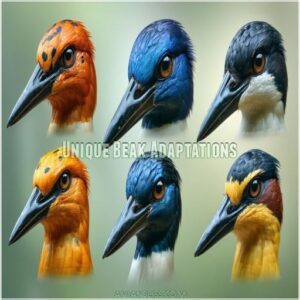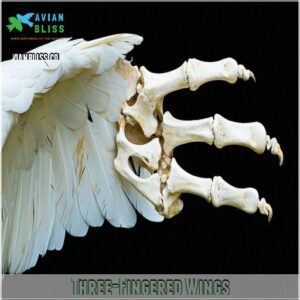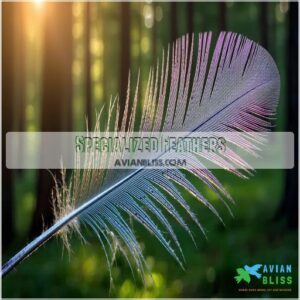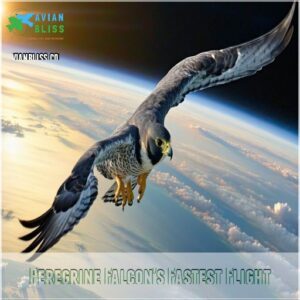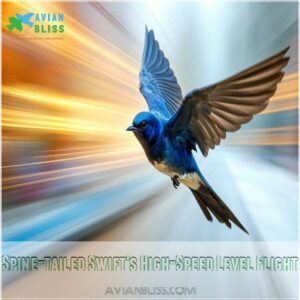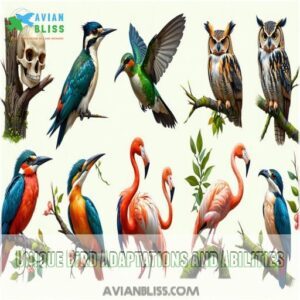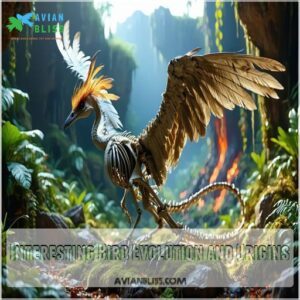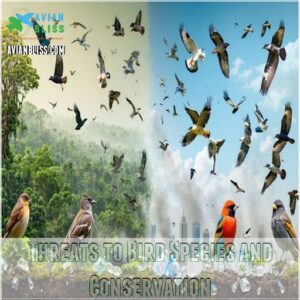This site is supported by our readers. We may earn a commission, at no cost to you, if you purchase through links.

Birds aren’t just feathered friends—they’re dinosaur descendants with mind-blowing adaptations.
Their three-fingered wings evolved from prehistoric ancestors, enabling jaw-dropping flight maneuvers. Peregrine falcons rocket through the sky at 240 mph, while Arctic terns migrate a stunning 44,000 miles annually.
Their unique lung systems and specialized feathers help them survive in extreme conditions.
From hummingbirds flying backward to woodpeckers drumming tree trunks, these flying marvels are nature’s engineering masterpieces.
Think you know birds? Wait until you discover the shocking secrets hiding behind those beaks and wings.
Table Of Contents
- Key Takeaways
- Amazing Bird Characteristics
- Bird Behavior and Social Structure
- Incredible Bird Migration Patterns
- Awesome Bird Speed and Agility
- Unique Bird Adaptations and Abilities
- Record-Breaking Bird Features
- Interesting Bird Evolution and Origins
- Threats to Bird Species and Conservation
- Cultural Significance and Symbolism of Birds
- Fascinating Bird Intelligence and Imitation
- Frequently Asked Questions (FAQs)
- What are some fun facts about birds?
- What is the most common bird in the world?
- What do you know about 15 amazing bird species?
- What are some cool birds?
- Why are birds so interesting?
- How many cool birds are featured in this article?
- What are 5 bird characteristics?
- What was the first bird in the world?
- What is the ugliest bird in the world?
- What is the most beautiful bird in the world?
- Conclusion
Key Takeaways
- You’ll discover birds are living dinosaur descendants with mind-blowing adaptations that let them survive in extreme conditions, from flying backward to rotating their heads nearly 360 degrees.
- Birds have evolved incredible survival strategies, including specialized lung systems, unique wing structures, and extraordinary migration patterns that allow some species to travel up to 44,000 miles annually.
- Their intelligence will shock you—many bird species can solve complex problems, use tools, and demonstrate remarkable social learning capabilities that rival those of many mammals.
- You’ll be amazed by the diversity of bird species, from the tiny bee hummingbird (weighing almost nothing) to the massive ostrich, each showcasing nature’s incredible ability to adapt and thrive in wildly different environments.
Amazing Bird Characteristics
You’ve never seen birds quite like this before – their anatomy is a marvel of evolutionary engineering that’ll make your jaw drop!
From three-fingered wings to ultra-efficient lungs, birds are biological powerhouses.
That challenge everything you thought you knew about animal adaptations.
Unique Beak Adaptations
Ever wondered how bird beaks are nature’s Swiss Army knives?
Different bird species sport incredibly specialized beak shapes that perfectly match their diet and lifestyle.
From long, thin probing beaks of nectar-sipping hummingbirds to powerful, crushing beaks of eagles, these incredible bill sizes reveal a fascinating link between bird anatomy and survival strategies.
These beak shapes perfectly illustrate the connection between form and function in nature.
Efficient Lung Structure
Breathing like a pro, birds rock an unbelievably efficient lung system that puts mammalian respiration to shame.
Their unique air sac system enables unidirectional airflow, maximizing oxygen extraction during flight.
This avian respiratory marvel allows birds to meet extreme metabolic demands, supporting their incredible ability to soar, dive, and navigate challenging environments with remarkable lung efficiency.
Three-Fingered Wings
Evolving from dinosaur ancestors, bird wings hide a fascinating secret: three specialized fingers that revolutionize flight mechanics.
Unlike human hands, these modified digits support wing structure, enabling incredible aerial maneuvers.
Fossil evidence reveals how these avian anatomy adaptations transformed prehistoric creatures into modern flying machines, showcasing nature’s remarkable design for efficient wing function.
Specialized Feathers
After those three-fingered wings, get ready to ruffle some feathers with nature’s most incredible wardrobe! Bird feathers aren’t just for looks – they’re engineering marvels that make flight possible.
- Feather structures enable precise temperature regulation
- Coloration serves complex camouflage and communication purposes
- Molting patterns protect birds through seasonal changes
- Unusual feather adaptations solve survival challenges
Your bird buddies are walking, flying fashion statements with built-in survival technology!
Bird Behavior and Social Structure
You’ll be amazed by the intricate social lives of birds, where cooperation and unique mating strategies reveal a world far more complex than you might imagine.
From lifelong flamingo partnerships to group hunting techniques, bird societies showcase remarkable behavioral patterns.
That’ll make you see these feathered creatures in a whole new light.
Cooperative Breeding and Hunting
Just when you thought birds were lone rangers, nature throws a curveball!
Some bird species are master team players, using kin selection and group defense to survive.
Whether it’s shared hunting tactics or collectively protecting their young, these feathered friends prove that cooperation isn’t just a human thing.
Prey capture becomes a group strategy that gives them a serious survival edge.
Monogamous Mating Systems
When birds flock together for breeding, most choose to stick with one partner – a strategy scientists call monogamous mating rituals.
These bird social behaviors aren’t just about romance; they’re survival tactics.
By pairing up, birds maximize parental care, protect their genetic investments, and increase offspring survival rates.
It’s nature’s smart way of ensuring the next generation takes flight successfully.
Polygynous and Polyandrous Mating Systems
By shaking up traditional bird romance, some species rock polygynous and polyandrous mating systems that’ll make your jaw drop.
These unconventional approaches maximize genetic diversity and survival chances, as seen in spectacular courtship displays.
- Multiple males or females share reproductive responsibilities
- Complex sexual selection drives unique pairing strategies
- Evolutionary pressures reshape traditional mating norms
- Parental care becomes a collaborative group effort
- Bird communication plays a key role in mate selection
Lifelong Pair Bonds in Flamingos
Swaying on slender legs, flamingos showcase an extraordinary commitment to love that puts human relationships to shame.
These pink-feathered romantics form lifelong pair bonds, with divorce rates incredibly low among bird species.
Their complex courtship rituals involve synchronized dancing, mutual preening, and elaborate social dynamics that cement their partnerships for years, sometimes decades.
Incredible Bird Migration Patterns
Ever wondered how birds navigate thousands of miles without GPS or road signs?
You’ll be amazed by the incredible migration patterns of Arctic terns, bar-headed geese, and other feathered travelers that push the boundaries of endurance and navigation.
Arctic Terns’ Longest Annual Migration
Nature’s marathon champions, Arctic terns redefine migration challenges with their epic yearly journey.
These feathered globetrotters showcase incredible endurance feats that’ll leave you speechless:
- Travel from Arctic to Antarctic and back annually
- Cover approximately 44,000 miles per bird migration
- Experience two summers in a single year
Their incredible navigation secrets push the boundaries of bird species survival, proving that some birds are true masters of long-distance flight.
Bar-headed Geese Flying Over The Himalayas
After witnessing Arctic terns’ epic journey, get ready for another mind-blowing migration story.
Bar-headed geese pull off the most insane high-altitude flight on the planet, soaring over the Himalayas at jaw-dropping heights.
These incredible birds navigate oxygen-starved peaks with unbelievable navigation skills, conquering extreme conditions that would ground any other creature in a heartbeat.
Sooty Terns’ Continuous Flight
Buckle up for a mind-blowing revelation about Sooty Terns, the marathon champions of the bird world! These incredible aviators defy gravity with their astonishing continuous flight. You can find various products related to their remarkable Sooty tern flight.
- Spend at least three years airborne without landing
- Master long-distance navigation across vast oceans
- Demonstrate unparalleled energy efficiency during flight
- Showcase remarkable adaptation to extreme environmental conditions
These feathered endurance athletes redefine the limits of bird migration.
Gentoo Penguins’ Fastest Swimming Speed
With lightning-fast underwater agility, Gentoo penguins rocket through frigid waters at astonishing speeds.
These incredible bird species can swim up to 22 miles per hour, making them the undisputed champions of swimming efficiency.
Their streamlined bodies and powerful flippers transform them into marine missiles, pursuing prey with remarkable hunting precision that’ll leave you stunned by their remarkable swimming technique.
Gentoo penguins are undisputed champions
Awesome Bird Speed and Agility
You won’t believe how mind-blowingly fast and agile birds can be, with some species reaching incredible speeds that’ll make your jaw drop.
Get ready to discover how nature’s feathered athletes soar, sprint, and zip through the air with jaw-dropping precision and speed.
That’ll leave you absolutely stunned.
Peregrine Falcon’s Fastest Flight
If nature had a speed demon, the Peregrine falcon would wear that crown. These aerial assassins redefine flight physics with mind-blowing hunting techniques that’ll make your jaw drop.
- Reach speeds up to 240 mph during hunting dives
- World’s fastest bird species
- Dive faster than a sports car accelerates
- Precise aerial predators with incredible evolutionary advantages
- Survive in diverse global habitats
Their top-speed prowess isn’t just show—it’s pure survival strategy.
Ostrich’s Fastest Running Speed
After the Peregrine Falcon‘s aerial prowess, let’s ground ourselves with another speed demon: the ostrich. These flightless birds rocket across African plains at jaw-dropping speeds up to 43 mph, making them the fastest running bird on the planet.
Their powerful legs and unique running mechanics transform desert landscapes into personal speedways.
| Ostrich Speed Fact | Incredible Detail |
|---|---|
| Top Speed | 43 miles per hour |
| Leg Power | Can cover 10-16 feet in single stride |
| Predator Evasion | Outrun most land predators |
| Evolutionary Advantage | Survival through speed |
Spine-tailed Swift’s High-Speed Level Flight
Rocket past the clouds, the Spine-tailed Swift blazes through the sky at a mind-blowing 100 mph during level flight.
These feathered speed demons showcase incredible flight mechanics and evolutionary adaptations that push the boundaries of bird speed records.
Their wing design and energy efficiency make them the ultimate aerial sprinters of the avian world.
Hummingbirds’ Ability to Fly Backward
Against the backdrop of nature’s aerial acrobatics, hummingbirds defy gravity with their jaw-dropping backward flight mechanics.
These tiny nectar-hunting marvels can zip in reverse, hover with precision, and dodge predators using unique wing adaptations.
Unlike other birds, they’ve evolved extraordinary flight capabilities that let them dance through the air with unparalleled agility and grace. hummingbirds backward flight mechanics extraordinary flight capabilities
Unique Bird Adaptations and Abilities
Ever wondered how birds survive in the most extreme conditions?
From woodpeckers drumming on trees to vultures with stomach acid that can dissolve bones,
birds have developed mind-blowing adaptations that’ll make you rethink everything you thought you knew about our feathered friends.
Woodpeckers’ Drumming on Trees
Ever wondered how woodpeckers become nature’s percussion experts?
These feathered drummers tap trees not just for food, but as a sophisticated communication method.
By rhythmically striking wood, they defend territories, attract mates, and signal their species’ presence.
Their specialized skull and neck muscles allow rapid, precise drumming that can reach up to 20 beats per second, transforming trees into their personal communication highways.
Owls’ Head Rotation and Acute Hearing
After woodpeckers drum up a storm, owls take center stage with their mind-blowing head rotation skills.
These nocturnal hunters can twist their heads nearly 360 degrees, a jaw-dropping adaptation that compensates for their fixed eye sockets.
Their acute hearing lets them pinpoint prey with laser-like precision, making them nature’s ultimate stealth hunters.
With silent flight and superhuman hearing, owls are the ninjas of the bird world.
Vultures’ Acidic Stomach Acid
Just when you thought owls were weird, vultures take bizarre to a whole new level.
Their stomach acid is so powerful it can dissolve anthrax bacteria, making these scavengers nature’s ultimate cleanup crew.
With a stomach lining that laughs in the face of deadly pathogens, vultures can feast on carrion that would make other bird species run for cover.
Kiwi’s Nocturnal and Flightless Nature
Almost every unique bird species tells a wild story, but the kiwi takes the cake for weirdest nocturnal adaptations.
These flightless New Zealand natives have traded wings for incredible ground-foraging skills, sporting nostrils at their beak’s tip and using keen senses to navigate dark forest floors.
The kiwi’s distinct characteristics have even inspired a variety of flightless kiwi bird merchandise.
Their remarkable evolution highlights nature’s creative problem-solving in bird conservation and survival.
Record-Breaking Bird Features
You won’t believe the jaw-dropping records birds can set in the wild!
From the tiniest eggs to the most incredible bill lengths,
these feathered wonders will leave you amazed at nature’s extraordinary designs.
Sword-billed Hummingbird’s Long Bill
In the wild world of cool bird facts, the sword-billed hummingbird stands out with its jaw-dropping bill longer than its entire body. This bizarre adaptation is a marvel of nature’s engineering.
Attracting sword-billed hummingbirds to your garden can be done by using Swordbill feeders, which provide them with essential nutrients.
This bizarre adaptation is a marvel of nature’s engineering.
In the wild world of cool bird facts, the sword-billed hummingbird stands out with its jaw-dropping bill longer than its entire body. This bizarre adaptation is a marvel of nature’s engineering.
- In the wild world of cool bird facts, the sword-billed hummingbird stands out with its jaw-dropping bill longer than its entire body. This bizarre adaptation is a marvel of nature’s engineering.
Australian Pelican’s Long Bill
After marveling at the sword-billed hummingbird’s bill, prepare to be amazed by the Australian pelican’s jaw-dropping bill length.
This record-breaking bird species boasts a bill that’s nature’s ultimate fishing tool.
Measuring impressively long, the pelican’s bill adaptation allows for incredible prey capture, showcasing how evolutionary pressures shape remarkable bird species characteristics with precision and purpose.
Ostrich’s Largest Egg
You might think big bills are impressive, but wait until you hear about the ostrich’s egg – nature’s heavyweight champion of bird reproduction. These massive eggs pack a serious punch, weighing up to 3 pounds and dwarfing every other bird’s contribution to the egg world. Remarkably, the ostrich egg’s size is likely an adaptation to its desert habitats, where it’s perfectly suited for survival.
- Each egg is roughly the size of 24 chicken eggs
- Shell thickness reaches up to 0.06 inches
- Weighs as much as a small cantaloupe
- Incredibly strong, capable of supporting an adult human’s weight
- Perfectly adapted for survival in harsh desert environments
The ostrich doesn’t mess around with egg reproduction.
Bee Hummingbird’s Smallest Egg
While an ostrich egg tips the scales, the bee hummingbird’s egg is nature’s tiniest marvel at just 0.02 ounces. Imagine a miniature egg smaller than a coffee bean!
| Bee Hummingbird Egg Facts | Details |
|---|---|
| Egg Weight | 0.02 ounces |
| Egg Length | 6mm (0.4 inches) |
| Nesting Habitat | Cuban forests |
These microscopic eggs showcase the incredible diversity of bird reproduction, proving that size doesn’t determine survival in the wild.
Interesting Bird Evolution and Origins
You’ll be amazed to discover that birds aren’t just feathered friends, but living descendants of dinosaurs who roamed the Earth millions of years ago.
As you explore their incredible journey, you’ll learn how these incredible creatures evolved from prehistoric avialans to become the diverse and remarkable species we see today.
Birds as The Only Living Dinosaurs
Ever wondered how your backyard robin is actually a dinosaur descendant?
Feathered flight isn’t just a modern marvel – it’s a direct link to prehistoric Theropoda.
Scientists have cracked the code: birds aren’t just bird-like dinosaurs, they ARE living dinosaurs.
Fossil evidence reveals these incredible Avian Evolution survivors, transforming from ancient predators to today’s winged wonders through mind-blowing evolutionary adaptations.
Archaeopteryx as The Oldest Known Bird
Nestled in the prehistoric landscape, the Archaeopteryx stands as a remarkable fossil bridging dinosaurs and modern birds.
These feathered dinosaurs, discovered in Germany’s Solnhofen limestone, reveal critical evolutionary links in early bird anatomy.
With wing-like limbs and primitive flight capabilities, Archaeopteryx represents a pivotal moment in bird evolution, showcasing the shift from ground-dwelling reptiles to aerial pioneers.
Rapid Diversification of Birds
Racing through evolutionary history, birds experienced a mind-blowing post-extinction radiation after the Cretaceous-Paleogene event.
The surviving Neornithes rapidly diversified into multiple ecological niches, driven by intense evolutionary pressures.
This adaptive radiation allowed bird species to exploit new environments, dramatically increasing genetic diversity and setting the stage for the incredible bird species we see today.
As a result of this rapid diversification, birds share a common ancestor with other reptiles, including birds and crocodiles share a closer relationship.
Threats to Bird Species and Conservation
You might be shocked to learn that human activities are pushing bird populations to the brink of extinction faster than you can say "tweet."
From habitat destruction to climate change, cats, and pollution,
these feathered friends are facing challenges that could wipe out entire species in just a few decades.
Habitat Loss and Fragmentation
While birds evolved from dinosaurs, their survival now hangs by a thread.
Habitat fragmentation slices through bird territories like a knife, leaving species vulnerable to extinction. Forests get chopped up, wetlands drain, and wildlife corridors disappear.
Your backyard might be the last refuge for some endangered birds, making conservation efforts more critical than ever.
Climate Change and Rising Temperatures
As habitat loss continues to squeeze bird populations, climate change is now throwing another curveball.
Rising temperatures are reshaping bird species’ survival strategies.
Migration patterns are shifting, breeding cycles are disrupted, and species extinction risk climbs.
Birds are scrambling to adapt, with some populations struggling to keep pace with rapid environmental transformations that threaten their very existence.
Pollution and Pesticide Poisoning
Here’s the content for the subtopic "Pollution and Pesticide Poisoning":
As global temperatures shift, another silent killer threatens bird populations: toxic pollution.
Pesticides accumulate in birds’ bodies through bioaccumulation, wreaking havoc on their delicate ecosystems.
These chemical cocktails disrupt hormones, weaken immune systems, and cause reproductive failures.
Bird conservation efforts spotlight these invisible threats, revealing how human activities can unintentionally decimate entire avian communities.
Cat Predation and Bird Mortality
Domestic cats pack a deadly punch for our feathered friends, massacring between 1.4 to 3.7 billion birds annually in the US alone.
These furry predators have become a massive threat to bird populations, turning neighborhoods into hunting grounds.
Wildlife experts recommend keeping cats indoors and creating bird-friendly spaces to help protect vulnerable species from becoming easy prey.
Cultural Significance and Symbolism of Birds
Ever wondered how birds have left their mark on human culture throughout history, from ancient myths to modern-day pop culture?
You’ll be amazed by the incredible ways these feathered creatures have inspired art, literature, and symbolism across civilizations, revealing a fascinating connection between humans and their winged companions.
Birds in Literature and Folklore
After battling bird extinction challenges, we’re flocking to stories where feathered friends take flight in literature and folklore.
From Harper Lee’s symbolic mockingbird to ancient myths, birds carry powerful narratives.
They’re not just characters—they’re messengers, symbols of freedom, and cultural storytellers that bridge human imagination with the wild, untamed spirit of avian mythology.
The bluebird, in particular, is often seen as a symbol of [hope and happiness](https://avianbliss.com/bluebird-meanings-and-symbolism/], representing a powerful narrative of transformation and renewal in various cultures.
Symbolic Meanings of Different Bird Species
Ever wondered how birds carry deep symbolic meanings across cultures?
Bird symbolism reveals fascinating insights into human imagination and spiritual connections.
These winged messengers represent powerful cultural interpretations:
- Owls embody wisdom and mystery
- Eagles symbolize freedom and strength
- Ravens signify transformation and intelligence
Each bird species weaves a unique narrative of mythological significance, bridging our understanding between nature and human experience.
Birds as a Source of Food and Materials
You’ve probably never thought about how birds are more than just pretty sights in the sky.
Birds have been key economic resources for centuries, providing bird meat, eggs, and valuable guano fertilizer.
From chicken farms to feather industries, humans have long relied on these winged creatures as essential sources of food, materials, and agricultural nutrients. This highlights the economic importance of birds.
Birds in Art and Cultural Expression
From feeding flocks to inspiring creativity, birds have soared beyond survival into the sphere of human imagination.
Their cultural footprint spans multiple domains:
- Mythology weaves birds as powerful symbols of freedom
- Literature transforms feathered creatures into metaphorical messengers
- Ancient art captures avian grace through intricate representations
- Fashion designers celebrate birds’ elegant plumage
- Folklore paints birds as spiritual intermediaries between worlds
Human expression takes flight on wings of wonder.
Fascinating Bird Intelligence and Imitation
Peck into the mind-bending world of bird intelligence, where feathered friends shatter expectations with their jaw-dropping cognitive abilities. These winged geniuses have skills that’ll make you question everything you thought you knew about animal smarts.
Birds have been observed exhibiting exceptional problem-solving abilities, mastering tasks that would challenge many mammals.
Crows and ravens are the Einsteins of the avian world, mastering problem-solving tasks that would challenge many mammals. Their social learning capabilities are off the charts – they can learn from each other, use tools, and even understand cause-and-effect relationships. Mimicry isn’t just a party trick; it’s a sophisticated skill that reveals deep intelligence. From complex vocal patterns to intricate social interactions, these birds prove that brains aren’t just a mammalian monopoly.
| Bird Species | Tool Use | Vocal Learning |
|---|---|---|
| Crows | Advanced | Moderate |
| African Grey Parrots | Basic | Exceptional |
| Ravens | Expert | Complex |
Frequently Asked Questions (FAQs)
What are some fun facts about birds?
Did you know birds are living dinosaurs?
They can fly backward and rotate their heads almost 360 degrees.
Species include the tiny bee hummingbird and the speedy Spine-tailed Swift soaring at 100 mph.
What is the most common bird in the world?
Regarding wild birds, you’ll be blown away by the Red-billed Quelea.
This tiny African finch takes the crown with a staggering 5 billion breeding pairs, making it the most populous wild bird on the planet.
What do you know about 15 amazing bird species?
You’ll be amazed by birds like the sword-billed hummingbird with its body-length bill.
The Arctic tern’s epic migration is also incredible.
And the tiny bee hummingbird – nature’s most incredible feathered marvels that’ll blow your mind!
What are some cool birds?
Imagine tiny hummingbirds hovering like helicopters beside massive soaring albatrosses.
Nature’s feathered marvels range from the sword-billed hummingbird to the Arctic tern.
Each species a breathtaking example of evolutionary brilliance and wild, untamed survival.
Why are birds so interesting?
Birds captivate you with their mind-blowing adaptations: dinosaur descendants that fly, communicate complex languages, survive extreme conditions, and shape entire ecosystems through incredible evolutionary tricks that’ll make your jaw drop.
How many cool birds are featured in this article?
Like feathered rockstars stealing the spotlight, this knowledge treasure trove showcases over a dozen fascinating avian celebrities.
From ultrasonic songbirds to egg-laying champions, you’ll discover an impressive lineup of winged wonders that’ll ruffle your curiosity.
What are 5 bird characteristics?
You’ll love discovering five wild bird traits: they’re living dinosaurs with unique respiratory systems.
They can rotate heads almost 360 degrees.
Their specialized toes are for gripping branches.
Birds produce ultrasonic songs.
And they lack bladders.
What was the first bird in the world?
Hold onto your time machines! Archaeopteryx, a feathered dinosaur from 150 million years ago, marks the earliest known bird-like creature.
This prehistoric marvel bridged the gap between dinosaurs and modern avian species, revolutionizing our understanding of evolution.
Archaeopteryx
What is the ugliest bird in the world?
When nature plays a cruel joke, the California Condor takes the crown for the ugliest bird.
With wrinkled, bald skin and a face only a mother could love, this scavenger proves beauty isn’t everything in the wild.
What is the most beautiful bird in the world?
Imagine spotting the resplendent quetzal – its iridescent emerald feathers and crimson belly dazzle bird lovers worldwide.
This Central American native embodies natural beauty, with a tail that can stretch up to three feet long.
Conclusion
Soaring beyond the boundaries of ordinary wildlife, cool bird facts reveal nature’s most extraordinary architects of evolution.
You’ve journeyed through a world where feathered marvels defy expectations, from lightning-fast falcons to globe-trotting terns.
These remarkable creatures aren’t just animals—they’re living proof of biological ingenuity.
Whether you’re a casual nature enthusiast or budding ornithologist, understanding birds opens a window into the breathtaking complexity of our planet’s most incredible flying survivors.

